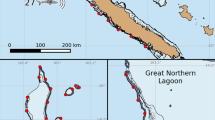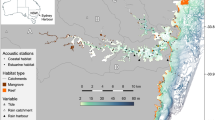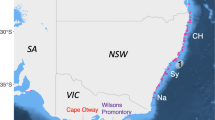Abstract
Understanding the movement ecology of marine species is important for conservation management and monitoring their responses to environmental change. In this study, adult and subadult bull sharks (Carcharhinus leucas; n = 16) were acoustically tagged in Biscayne Bay, Florida (USA), where they were tracked locally via an array of 40 passive acoustic receivers, as well as regionally via cooperative acoustic telemetry networks, with individuals tracked up to 4.5 years. Detection data were used to assess philopatry, regional connectivity, and environmental correlates of shark habitat use. Spatial range varied per individual; however, most individuals displayed high residency to Biscayne Bay, exhibiting strong philopatric behavior to the tagging area. A generalized linear mixed model revealed a seasonal pattern in habitat use, with mature females displaying high residency in Biscayne Bay during the colder dry season (November to February) and lower residencies during the warmer wet season (June to October). These seasonal patterns were supported by catch data from long-term fishery-independent shark surveys in the study area. During summer months when residencies of C. leucas declined in Biscayne Bay, their residencies increased in other regions (e.g., Florida Gulf Coast), demonstrative of seasonal migrations. Connectivity between areas of high use (Biscayne Bay and Florida Gulf Coast) was demonstrated by some individuals traveling between these areas. Results from generalized additive mixed models suggest that these movement patterns could be partially driven by seasonal changes in environmental variables as well as an individual’s life stage, including reproductive status.




Similar content being viewed by others
Data availability and online material
Raw acoustic tracking data are archived and is available at the Ocean Tracking Network’s data warehouse website: https://members.oceantrack.org/.
Code availability
The code used for data preparation, manipulation, and analysis can be found on Github at this link: https://github.com/lauramcdonnell/UMsharktagging/blob/master/manuscripts/bullshark/bull_script.R.
References
Altobelli AN, Szedlmayer ST (2020) Migration and residency of sandbar, Atlantic sharpnose, bull, and nurse sharks in the Northern Gulf of Mexico. North Am J Fish Manag 40:1324–1343
Bailey H, Benson SR, Shillinger GL et al (2012) Identification of distinct movement patterns in Pacific leatherback turtle populations influenced by ocean conditions. Ecol Appl 22:735–747. https://doi.org/10.1890/11-0633
Bangley CW, Paramore L, Shiffman DS, Rulifson RA (2018) Increased abundance and nursery habitat use of the bull shark (Carcharhinus leucas) in response to a changing environment in a warm-temperate estuary. Sci Rep 8:1–10
Bangley CW, Whoriskey FG, Young JM, Ogburn MB (2020) Networked animal telemetry in the Northwest Atlantic and Caribbean waters. Mar Coast Fish 12:339–347
Bansemer CS, Bennett MB (2009) Reproductive periodicity, localised movements and behavioural segregation of pregnant Carcharias taurus at Wolf Rock, southeast Queensland, Australia. Mar Ecol Prog Ser 374:215–227
Bates D, Mächler M, Bolker B, Walker S (2014) Fitting linear mixed-effects models using lme4. ArXiv Prepr. arXiv:1406.5823
Birkmanis CA, Freer JJ, Simmons LW et al (2020) Future distribution of suitable habitat for pelagic sharks in Australia under climate change models. Front Mar Sci. https://doi.org/10.3389/fmars.2020.00570
Bond ME, Babcock EA, Pikitch EK et al (2012) Reef sharks exhibit site-fidelity and higher relative abundance in marine reserves on the Mesoamerican Barrier Reef. PLoS ONE 7:e32983
Brand LE, Pablo J, Compton A, Hammerschlag N, Mash DC (2010) Cyanobacterial blooms and the occurrence of the neurotoxin beta-N-methylamino-L-alanine (BMAA) in South Florida Aquatic Food Webs. Harmful Algae 9:620–635
Branstetter S, Stiles R (1987) Age and growth estimates of the bull shark, Carcharhinus leucas, from the northern Gulf of Mexico. Environ Biol Fishes 20:169–181
Browder JA, Alleman R, Markley S et al (2005) Biscayne Bay conceptual ecological model. Wetlands 25:854. https://doi.org/10.1672/0277-5212(2005)025[0854:BBCEM]2.0.CO;2
Caccia VG, Boyer JN (2005) Spatial patterning of water quality in Biscayne Bay, Florida as a function of land use and water management. Mar Pollut Bull 50:1416–1429
Calich H, Estevanez M, Hammerschlag N (2018) Overlap between highly suitable habitats and longline gear management areas reveals vulnerable and protected regions for highly migratory sharks. Mar Ecol Prog Ser 602:183–195. https://doi.org/10.3354/meps12671
Carlson JK, Ribera MM, Conrath CL et al (2010) Habitat use and movement patterns of bull sharks Carcharhinus leucas determined using pop-up satellite archival tags. J Fish Biol 77:661–675. https://doi.org/10.1111/j.1095-8649.2010.02707.x
Castro JI (2010) The sharks of North America. Oxford University Press, Oxford
Cooke SJ (2008) Biotelemetry and biologging in endangered species research and animal conservation: relevance to regional, national, and IUCN Red List threat assessments. Endanger Species Res 4:165–185
Cooke SJ, Iverson SJ, Stokesbury MJW et al (2011) Ocean tracking network Canada: a network approach to addressing critical issues in fisheries and resource management with implications for ocean governance. Fisheries 36:583–592. https://doi.org/10.1080/03632415.2011.633464
Crossin GT, Heupel MR, Holbrook CM et al (2017) Acoustic telemetry and fisheries management. Ecol Appl 27:1031–1049
Currier R, Kirkpatrick B, Simoniello C, et al (2015) iTAG: Developing a cloud based, collaborative animal tracking network in the Gulf of Mexico. In: OCEANS 2015 - MTS/IEEE Washington. pp 1–3
Curtis TH, Adams DH, Burgess GH (2011) Seasonal distribution and habitat associations of bull sharks in the Indian River Lagoon, Florida: A 30-year synthesis. Trans Am Fish Soc 140:1213–1226. https://doi.org/10.1080/00028487.2011.618352
Daly R, Smale MJ, Cowley PD, Froneman PW (2014) Residency patterns and migration dynamics of adult bull sharks (Carcharhinus leucas) on the east coast of southern Africa. PLoS ONE 9:e109357
Drymon JM, Carassou L, Powers SP et al (2013) Multiscale analysis of factors that affect the distribution of sharks throughout the northern Gulf of Mexico. Fish Bull 111:370–380
Friess C, Lowerre-Barbieri S, Poulakis G, Hammerschlag N, Gardiner J, Kroetz A, Bassos-Hull K, Bickford J, Bohaboy E, Ellis R, Menendez H, Patterson W, Price ME, Rehage JS, Shea CP, Smukall MJ, Walters-Burnsed S, Wilkinson KA, Young J, Collins A, DeGroot B, Peterson CT, Purtelbaugh C, Randall M, Scharer RM, Schloesser RW, Wiley TR, Alvarez GA, Danylchuck A, Fox AG, Grubbs RD, Hill A, Locascio J, O’Donnell PM, Skomal G, Whoriskey F, Griffen L (2020) Regional scale variability in the movement ecology of marine fishes revealed by an integrative acoustic tracking network. Mar Ecol Prog Ser. https://doi.org/10.3354/meps13637
Froeschke J, Stunz G, Wildhaber M (2010) Environmental influences on the occurrence of coastal sharks in estuarine waters. Mar Ecol Prog Ser 407:279–292. https://doi.org/10.3354/meps08546
Gallagher A, Serafy J, Cooke S, Hammerschlag N (2014) Physiological stress response, reflex impairment, and survival of five sympatric shark species following experimental capture and release. Mar Ecol Prog Ser 496:207–218. https://doi.org/10.3354/meps10490
Graham F, Rynne P, Estevanez M et al (2016) Use of marine protected areas and exclusive economic zones in the subtropical western North Atlantic Ocean by large highly mobile sharks. Divers Distrib 22:534–546. https://doi.org/10.1111/ddi.12425
Griffin LP, Brownscombe JW, Adams AJ et al (2018) Keeping up with the Silver King: using cooperative acoustic telemetry networks to quantify the movements of Atlantic tarpon (Megalops atlanticus) in the coastal waters of the southeastern United States. Fish Res 205:65–76. https://doi.org/10.1016/j.fishres.2018.04.008
Guttridge TL, Van Zinnicq Bergmann MP, Bolte C et al (2017) Philopatry and regional connectivity of the great hammerhead shark, Sphyrna mokarran in the US and Bahamas. Front Mar Sci 4:3
Hammerschlag N, Davis DA, Mondo K, Seely MS, Murch SJ, Glover WB, Divoll T, Evers DC, Mash DC (2016) Cyanobacterial neurotoxin BMAA and mercury in sharks. Toxins 8:238
Hammerschlag N, Gallagher AJ, Lazarre DM (2011) A review of shark satellite tagging studies. J Exp Mar Biol Ecol 398:1–8. https://doi.org/10.1016/j.jembe.2010.12.012
Hammerschlag N, Gutowsky LFG, Gallagher AJ et al (2017) Diel habitat use patterns of a marine apex predator (tiger shark, Galeocerdo cuvier) at a high use area exposed to dive tourism. J Exp Mar Biol Ecol 495:24–34. https://doi.org/10.1016/j.jembe.2017.05.010
Hammerschlag N, Luo J, Irschick DJ, Ault JS (2012) A comparison of spatial and movement patterns between sympatric predators: bull sharks (Carcharhinus leucas) and Atlantic tarpon (Megalops atlanticus). PLoS ONE 7:e45958. https://doi.org/10.1371/journal.pone.0045958
Hammerschlag N, Sulikowski J (2011) Killing for conservation: the need for alternatives to lethal sampling of apex predatory sharks. Endanger Spec Res 14:135–140
Hays GC, Bailey H, Bograd SJ et al (2019) Translating marine animal tracking data into conservation policy and management. Trends Ecol Evol 34:459–473. https://doi.org/10.1016/j.tree.2019.01.009
Howey-Jordan LA, Brooks EJ, Abercrombie DL et al (2013) Complex movements, philopatry and expanded depth range of a severely threatened pelagic shark, the oceanic whitetip (Carcharhinus longimanus) in the western North Atlantic. PLoS ONE 8:e56588
Hussey NE, Kessel ST, Aarestrup K et al (2015) Aquatic animal telemetry: a panoramic window into the underwater world. Science. https://doi.org/10.1126/science.1255642
Jacoby DMP, Papastamatiou YP, Freeman R (2016) Inferring animal social networks and leadership: applications for passive monitoring arrays. J R Soc Interface 13:20160676. https://doi.org/10.1098/rsif.2016.0676
Jirik KE, Lowe CG (2012) An elasmobranch maternity ward: female round stingrays Urobatis halleri use warm, restored estuarine habitat during gestation. J Fish Biol 80:1227–1245
Kessel S, Chapman D, Franks B et al (2014a) Predictable temperature-regulated residency, movement and migration in a large, highly mobile marine predator (Negaprion brevirostris). Mar Ecol Prog Ser 514:175–190
Kessel S, Cooke S, Heupel M et al (2014b) A review of detection range testing in aquatic passive acoustic telemetry studies. Rev Fish Biol Fish 24:199–218
Knip DM, Heupel MR, Simpfendorfer CA (2012) Evaluating marine protected areas for the conservation of tropical coastal sharks. Biol Conserv 148:200–209. https://doi.org/10.1016/j.biocon.2012.01.008
Krueger ET, Jose F (2018) Seasonal and inter-annual variability in sea surface temperature and chlorophyll-a concentration along the West Florida Shelf: analyzing 5 years of satellite data. In: Ocean Sensing and Monitoring X. International Society for Optics and Photonics, p 106310B
Laurrabaquio-A NS, Islas-Villanueva V, Adams DH et al (2019) Genetic evidence for regional philopatry of the Bull Shark (Carcharhinus leucas), to nursery areas in estuaries of the Gulf of Mexico and western North Atlantic Ocean. Fish Res 209:67–74
Lee K, Smoothey A, Harcourt R et al (2019) Environmental drivers of abundance and residency of a large migratory shark, Carcharhinus leucas, inshore of a dynamic western boundary current. Mar Ecol Prog Ser 622:121–137
Lenth R, Singmann H, Love J et al (2019) Estimated marginal means, aka least-squares means. R package version 1(3):2
Manire CA, Rasmussen L, Hess DL, Hueter RE (1995) Serum steroid hormones and the reproductive cycle of the female bonnethead shark, Sphyrna tiburo. Gen Comp Endocrinol 97:366–376
McDonnell LH, Jackson TJ, Burgess GH et al (2020) Saws and the city: smalltooth sawfish (Pristis pectinata) encounters, recovery potential and research priorities in urbanized coastal waters off Miami. Endanger Species Res, Florida. https://doi.org/10.3354/esr01085
Medina-Lopez E, Ureña-Fuentes L (2019) High-resolution sea surface temperature and salinity in coastal areas worldwide from raw satellite data. Remote Sens 11:2191. https://doi.org/10.3390/rs11192191
Millette N, Kelble C, Linhoss A et al (2019) Using spatial variability in the rate of change of chlorophyll a to improve water quality management in a subtropical oligotrophic estuary. Estuaries Coasts 42:1792–1803
Niella Y, Smoothey AF, Peddemors V, Harcourt R (2020) Predicting changes in distribution of a large coastal shark in the face of the strengthening East Australian Current. Mar Ecol Prog Ser 642:163–177
Nosal AP, Caillat A, Kisfaludy EK, Royer MA, Wegner NC (2014) Aggregation behavior and seasonal philopatry in male and female leopard sharks Triakis semifasciata along the open coast of southern California, USA. Mar Ecol Prog Ser 499:157–175
Ortega LA, Heupel MR, Van Beynen P, Motta PJ (2009) Movement patterns and water quality preferences of juvenile bull sharks (Carcharhinus leucas) in a Florida estuary. Environ Biol Fishes 84:361–373
Rider MJ (2020) Habitat use patterns of coastal shark species in relation to boat activity along an urban marine gradient. Master’s Thesis, University of Miami
Rudnick DT, Ortner PB, Browder JA, Davis SM (2005) A conceptual ecological model of Florida Bay. Wetlands 25:870–883. https://doi.org/10.1672/0277-5212(2005)025[0870:ACEMOF]2.0.CO;2
Shipley ON, Gallagher AJ, Shiffman DS, Kaufman L, Hammerschlag N (2019) Diverse resource-use strategies in a large-bodied marine Predator guild: evidence from differential use of resource subsidies and intraspecific isotopic variation. Mar Ecol Prog Ser 623:71–83
Simpfendorfer CA, Freitas GG, Wiley TR, Heupel MR (2005) Distribution and habitat partitioning of immature bull sharks (Carcharhinus leucas) in a southwest Florida estuary. Estuaries 28:78–85
Skubel RA, Wilson K, Papastamatiou YP et al (2020) A scalable, satellite-transmitted data product for monitoring high-activity events in mobile aquatic animals. Anim Biotelemetry 8:34. https://doi.org/10.1186/s40317-020-00220-0
Speed CW, Cappo M, Meekan MG (2018) Evidence for rapid recovery of shark populations within a coral reef marine protected area. Biol Conserv 220:308–319. https://doi.org/10.1016/j.biocon.2018.01.010
Sulikowski J, Wheeler CR, Gallagher AJ, Prohaska BK, Langan JA, Hammerschlag N (2016) Seasonal and life-stage variation in the reproductive ecology of a marine apex predator, the tiger shark Galeocerdo cuvier, at a protected female dominated site. Aquat Biol 24:175–184
Tillett B, Meekan M, Field I et al (2012) Evidence for reproductive philopatry in the bull shark Carcharhinus leucas. J Fish Biol 80:2140–2158
Torres LG, Heithaus MR, Delius B (2006) Influence of teleost abundance on the distribution and abundance of sharks in Florida Bay, USA. Hydrobiologia 569:449–455. https://doi.org/10.1007/s10750-006-0148-6
USACE (United States Army Corps of Engineers) (2019) Comprehensive Everglades Restoration Plan Biscayne Bay Coastal Wetlands. Fact Sheet. https://www.saj.usace.army.mil/About/Congressional-Fact-Sheets-2019/CERP-Biscayne-Bay-Coastal-Wetlands-C/. Accessed 10 Oct 2020
Wiley TR, Simpfendorfer CA (2007) The ecology of elasmobranchs occurring in the Everglades National Park, Florida: implications for conservation and management. Bull Mar Sci 80:171–189
Wood SN (2004) Stable and efficient multiple smoothing parameter estimation for generalized additive models. J Am Stat Assoc 99:673–686
Acknowledgements
This research was supported by the contributions of all the University of Miami’s Shark Research and Conservation Program team members who assisted in this project. Special thanks to Stephen Cain, Carl Hampp, Robbie Roemer, Austin Gallagher, and Abby Tinari for logistical support. For their equipment and technical support, we thank several collaborative networks and their contributing members: Florida Atlantic Coast Telemetry Network, Ocean Tracking Network, Integrated Tracking of Aquatic Animals in the Gulf of Mexico, and Mid-Atlantic Acoustic Telemetry Observation System.
Funding
This work was supported by funds from the Batchelor Foundation, Herbert W. Hoover Foundation, Ocean Tracking Network, Save Our Seas Foundation, and Disney Conservation Fund.
Author information
Authors and Affiliations
Contributions
Conceptualization: MR; Methodology: MR and LM; Formal analysis and investigation: MR and LM; Writing – original draft preparation: MR and LM; Writing – review and editing: MR, LM, and NH; Funding acquisition: NH; Supervision: NH.
Corresponding author
Ethics declarations
Conflict of interest
The authors have no conflict of interest to declare that are relevant to the content of this article.
Consent for publication
All authors consent to the publication of all material presented in this manuscript.
Ethics approval
This work was conducted under permits from Florida Fish and Wildlife Conservation Commission, the Florida Keys National Marine Sanctuary, the US National Marine Fisheries Service, and the University of Miami Animal Welfare and Care Committee (Protocol 18–154).
Additional information
Publisher's Note
Springer Nature remains neutral with regard to jurisdictional claims in published maps and institutional affiliations.
Handling Editor: Télesphore Sime-Ngando
Supplementary information
Distribution of acoustic telemetry receivers in Biscayne Bay, Florida.
Table showing detailed inter-regional movements of each individual. Each row displays information on when an individual arrived in a region, left that region, the number of detections that occurred, the amount of time spent, and a mean latitude and longitude of all receivers in that region the individual was detected on during said event.
Mean chlorophyll levels (mg m-3) as extracted from NOAA’s ERDAPP database (Aqua MODIS NPP 0.025 product) in Biscayne Bay study region between 2015 and 2020 (averaged monthly).
Rights and permissions
About this article
Cite this article
Rider, M.J., McDonnell, L.H. & Hammerschlag, N. Multi-year movements of adult and subadult bull sharks (Carcharhinus leucas): philopatry, connectivity, and environmental influences. Aquat Ecol 55, 559–577 (2021). https://doi.org/10.1007/s10452-021-09845-6
Received:
Accepted:
Published:
Issue Date:
DOI: https://doi.org/10.1007/s10452-021-09845-6




